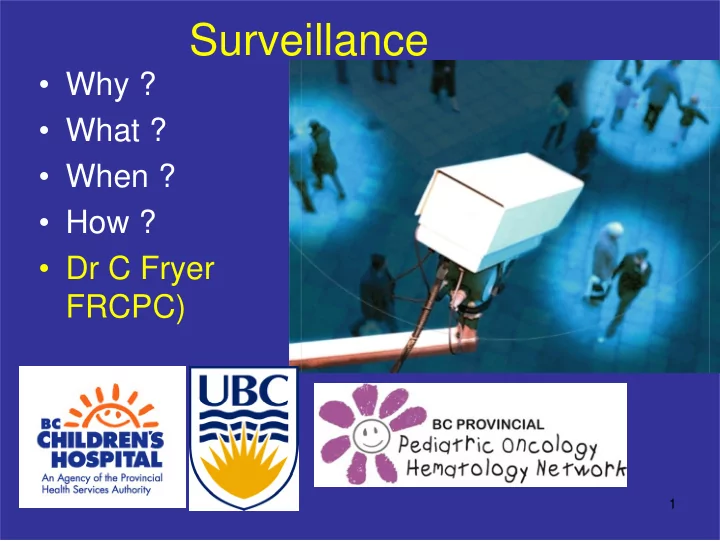

Surveillance • Why ? • What ? • When ? • How ? • Dr C Fryer FRCPC) 1
Disclosure; • Disclosure; None. • I have no conflicts. • I have no industry financial relationships.
Background: Background: • Relapse is the single most likely late effect (5%@10yrs 6%@20yrs) • Screening tests for relapse in 5yr survivors limited benefit and increased psychological stress. Possible exception Ewings sarcoma which has 13% cumulative relapse @20yrs • The same might be said in regards to many of the surveillance tests for late effects. • What screening tests and their frequency is controversial and is a focus of the International Guideline Harmonization Group (IGHG). • Current North American recommendations utilize the 2013 Children’s Oncology Group consensus based guidelines: Refs: Childhood cancer: Long-term follow-up Foundation for Medical Practice Education Education Module Vol22(5) May 2014 www.fmpe.org https://members.fmpe.org/ http://www.survivorshipguidelines.org/pdf/LTFUGuidelines_40.pdf
BCCH Recommendations • All survivors should have annual history and physical. Healthy adult survivors can be screened by their primary health care provider for adverse health issues such as life-style, healthy heart, dental problems, obesity, hypertension, physical inactivity and psychological aspects. • Screening tests should be selective and based on decreasing morbidity, mortality and improving quality of life for patients at significant risk • The study by Hudson clearly identified the risk for specific organ toxicities based on therapy received (JAMA 2013;309:2371-81) • Studies by Landier W. ( J Clin Oncol 2012;30:4401-8) and Wong FL. ( Ann Int Med 2014;160:672-83) suggest that less frequent monitoring than the COG guidelines may be more cost effective and expose patients to less psychological stress. Requires study
Proposed screening for “healthy” adult survivors of childhood cancer Pediatric Organ system Proposed test Benefit Action population Females, Endocrine Anti Mullerian Predictor of early Oocyte cryo- alkylator Fertility hormone menopause preservation. CED>8gm/m 2 Female (FSH,LH,) early pregnancy XRT ovaries hormonal hypothal/pit During reproductive replacement period Males, alkylators, Endocrine FSH/LH/ Predicts Leydig Testosterone (CED>8gm/m 2 ) Fertility Testosterone cell failure replacement XRT to Male Sperm analysis (Prevention sperm hypothal/pit /testes freezing) Post pubertal XRT to thyroid Thyroid T4/TSH Asymptomatic Thyroid region/hypothal/pit Recommended Hypothyroidism replacement annually Refer to Exclude ACTH XRT hypothal/pit Pituitary Replacement Endocrinologist /GH deficiency therapy Medical alert bracelet
Proposed cardiac screening Pediatric Organ system Proposed test Benefit Action population Anthracyclines Cardiac Echo/ECG Identifies Rx ACE **(>250mg/m 2 ) Frequency asymptomatic inhibitors etc XRT to heart dependant on risk** toxicity NT-proBNP^^^ XRT to great Cardiovascular Examination Identifies ?low dose aspirin vessels ischemia (Bruit?MRI) asymptomatic ? Early surgery Annually **Risk dependant on: Age when anthracycline given >250 Dose of anthracycline Radiation to heart <250 Gender zero Genetic profiling ^^^Plasma N-terminal pro-brain natriuretic peptide (Ylanan K Acta paediatr 2015;104:313-9)
COG Recommended frequency of echocardiogram Age at treatment XRT to heart Anthracycline dose Frequency < 1yr old Yes any Every year No <200mg/m2 Q2 yrs >200mg/m2 Every year 1-4yr old Yes any Every year No <100mg/m2 Every 5 yrs >100<300mg/m2 Every 2 yrs >300mg/m2 Every year >5yr old Yes <300mg/m2 Every 2 yrs >300mg/m2 Every year No <200mg/m2 Every 5 yrs >200<300mg/m2 Every 2 yrs >300mg/m2 Every year Any age with decrease in serial function Every year
Risk factors female 1 Age <5 2 • Chow EJ Individual prediction of heart failure among childhood cancer survivors J Clin Oncol 2015;33: 394- 5-14 1 402 Risk of CHF by age 40yrs Anthracycline <100 1 100-249mg/m2 2 • Low risk score < 3 or No anthracycline no XRT risk 0.5% >250mg/m2 4 ? no monitoring Chest XRT <5 Gy 1 • Moderate risk score 3-5 risk 2.5-5% ? Echo q 5yrs 5-14 Gy 2 • High risk score 6-8 risk 8-10% 15-34 Gy 3 ? Echo q 2 yrs >34Gy 4 • V high risk score >8 risk 15-33% ? Echo annually Obesity 1 • In future genetic factors will be Hypertension 2 included
Proposed screening for second cancers in irradiated survivors Pediatric Second neoplasm Proposed test Benefit Action population Females with Breast MRI breast Earlier Less advanced chest XRT Mammography detection disease survival Start 8yrs post benefit? XRT or age 25yrs annual Neck XRT Thyroid Ultrasound Earlier Less advanced detection disease survival Thyroid benefit? Q5yrs 5yrs post Rx XRT 35Gy+ to Colonoscopy Earlier Less advanced Colon cancer abdomen/pelvis detection disease survival Annually from benefit? Age 35yrs Brain XRT Brain MRI brain Earlier Less advanced meningioma detection disease survival Q5yrs 10 yrs benefit? post Rx
Recommend
More recommend